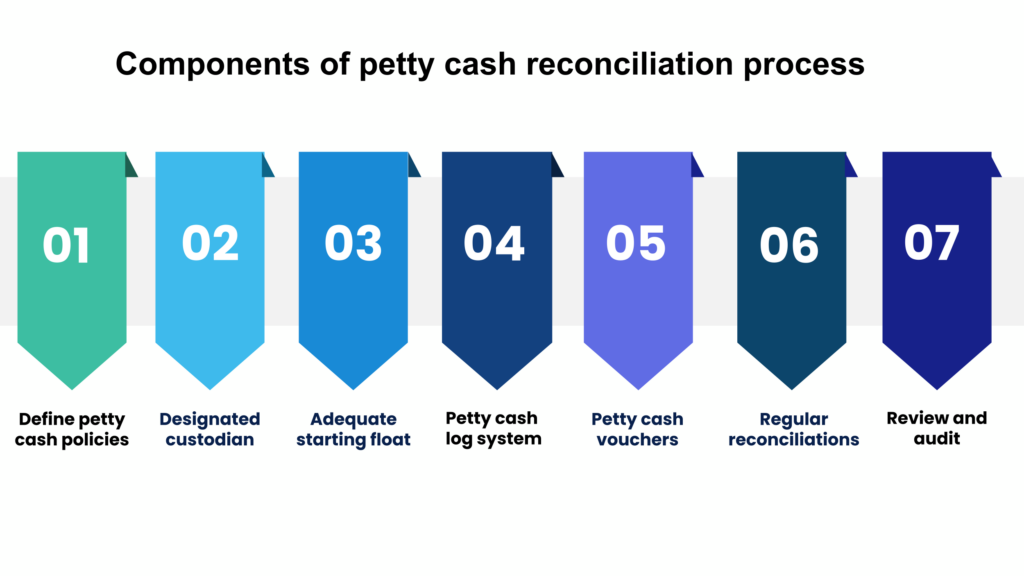Last Updated on November 28, 2025
Introduction
Petty cash is a small amount organizations keep on hand for minor expenses like office supplies. But do you know, despite its small amount, petty cash can quickly add up and increase the scope of financial mismanagement for your organization if not reconciled and managed properly?
This guide looks at the importance of petty cash reconciliation for organizations. Furthermore, we will explore the importance of petty cash expenses for financial management, the best practices for managing and reconciling them, and the tools and software that can help make the process easier and more efficient.
Read More: Petty Cash Meaning: A Guide to Record, Manage and Example
What is petty cash reconciliation?
Petty cash reconciliation is verifying and reconciling transactions involving petty cash funds. The process involves comparing the total petty cash expenses in the accounting records to the actual cash disbursed from the petty cash fund.
The petty cash account reconciliation process primarily ensures that petty cash funds are used appropriately and that the cash records accurately reflect the expenses. It also acts as an internal control mechanism for fraud prevention by identifying discrepancies or inconsistencies in using the petty cash fund.
For instance, let’s assume a small business has a petty cash fund of INR 20,000 to cover minor expenses. During the month, the employees used the petty cash fund to make several small purchases worth INR 12,000.
At the end of the month, the finance manager would review the cash receipts and other documentation for each expense withdrawal and compare them to the amount of cash disbursed from the petty cash fund. Any discrepancies in the petty cash fund will be identified and resolved.
Quick Read: Petty Cash Accounting: 6 Steps to Setup, Reconciliation, Challenges
When should petty cash reconciliation be used?
Petty cash reconciliation should be used regularly, preferably monthly or bi-monthly, to ensure financial records match the expenses.
Regular reconciliation of petty cash is essential in the following ways:
- Helps identify discrepancies in the use of the petty cash fund
- Provides an opportunity to review the expenses and ensure that they are authorized
- Allows to investigate and resolve minor discrepancies before they become bigger issues
- Helps establish a pattern of usage that is useful for budgeting and forecasting purposes
- Identifies areas of opportunity to reduce expenses or improve processes
Important terms related to petty cash reconciliation
Here are the important terms related to petty cash reconciliation essential to ensuring the effective management of petty cash funds:
- Float: It is the fund’s starting balance determined by the organization’s financial policies and procedures.
- Log: It is a document that records all petty cash transactions. The log includes the transaction date, the amount, and the purpose of the payment.
- Vouchers: They are part of the log system and show individual petty cash payments.
- Disbursements: It is the payment made using petty cash funds.
- Custodian: It is the person responsible for managing the petty cash fund.
Future Read: Petty Cash Book: Types, Format, Operations, Pros and Cons
How to do petty cash reconciliation?
Time needed: 1 minute
The following is a step-by-step process for conducting petty cash reconciliation:
- Count the cash in the petty cash lockbox
The custodian should count the cash in the petty cash fund and document it in the petty cash log.
- Collect all petty cash vouchers
The custodian should collect all petty cash vouchers and ensure they are properly completed and signed by the person who received the payment.
- Record all vouchers in the petty cash log
The custodian should record all vouchers in the petty cash log, including the date, the amount, and the purpose of the payment.
- Total the vouchers
The custodian should total the vouchers to determine the total amount of petty cash disbursements.
- Replenishment of the petty cash box
If the cash in the petty cash box is less than the total of the vouchers, the custodian should replenish the petty cash box by withdrawing cash from the organization’s bank account. The amount withdrawn should equal the total of the vouchers minus the cash in the petty cash box.
- Update accounting records
The custodian should update the accounting records to reflect the petty cash disbursements. This should include debiting the appropriate expense accounts and crediting the petty cash account.
- Reconcile petty cash
The final step involves comparing the cash in the petty cash box to the total of the vouchers and ensuring they match. If there are any discrepancies, the custodian should investigate and resolve them before finalizing the reconciliation.
Suggested Read: 10 Best Expense Management Software and Tools
Components of a successful petty cash reconciliation process
A successful petty cash reconciliation process should include the following components:

- Clearly defined policies and procedures
- Designated custodian
- Adequate starting float
- Petty cash log system
- Petty cash vouchers
- Regular reconciliations
- Review and audit
Establishing a petty cash reconciliation system
Here are some steps that can help you establish a solid petty cash reconciliation system for your organization:
STEP 1: Define petty cash policies and procedures
Defining clear policies and procedures should include specifying guidelines for who can access the petty cash funds, how they will be used, and how they will be replenished.
STEP 2: Assign a custodian
The custodian should be trained on the policies and procedures and understand the reconciliation process well.
STEP 3: Determine the starting float
The starting float should be determined based on the organization’s needs and sufficient to cover expenses for 15 to 30 days.
STEP 4: Establish a petty cash log system
The system should include a logbook that records the transaction’s date, purpose, and amount and the name of the person who received the cash.
STEP 5: Issue petty cash vouchers
Petty cash vouchers should be issued to employees who need to make petty cash transactions.
STEP 6: Conduct regular reconciliations
Reconciliations should happen at least once a month and involve comparing the cash in the petty cash box to the total of the vouchers.
STEP 7: Update accounting records
Accounting records should be updated regularly to reflect petty cash transactions. This should include debiting the appropriate expense accounts and crediting the petty cash account.
Future Read: What You Should Know About Petty Cash Reimbursement?
Best practices for effective petty cash reconciliation
Here are some best practices you can consider for conducting effective petty cash reconciliation for your organization:
- Regular reconciliations: Regular reconciliations should be conducted at least once a month to ensure that the petty cash funds are managed effectively.
- Clear documentation: All petty cash transactions should be documented in a logbook, including the date of the transaction, the purpose of the transaction, the amount of the transaction, and the name of the person who received the cash.
- Segregation of duties: Different individuals should be responsible for managing petty cash funds and conducting reconciliations. It ensures there is a system of checks and balances in place.
- Clear policies and procedures: A well-defined set of policies and procedures for managing petty cash funds should be established. This should include guidelines for who can access the funds, how they can be used, and how they will be replenished.
- Regular audits: A regular audit ensures the petty cash reconciliation process is working effectively and helps identify areas of improvement.
Petty cash reconciliation procedures and policy
While petty cash is a convenient way to manage small expenditures, it can also be vulnerable to theft and misuse. Having robust petty cash reconciliation procedures and policies thus becomes crucial. Without proper procedures, employees can easily take advantage of the system and siphon off funds for personal use.
A clear and transparent reconciliation process helps deter fraudulent activity and ensures petty cash is used for its intended purpose. Furthermore, strong petty cash procedures ensure accuracy and accountability in financial reporting. Your financial statements will be accurate and comply with applicable accounting standards.
Petty cash reconciliation problems and solutions
Here are some common petty cash reconciliation problems and solutions that can help organizations prevent future problems:
1. Errors in recording
It happens when transactions are not properly documented, or there are mistakes in adding or subtracting funds. You should establish clear guidelines for documenting transactions and ensure all employees are trained to record transactions accurately. Regular checks should also be conducted to prevent errors.
2. Discrepancies in cash balances
Discrepancies occur when there are differences between the amount of cash on hand and the recorded cash balance. This may be due to theft, fraud, or recording or counting cash errors. You should regularly audit your petty cash balances and establish clear guidelines for managing petty cash.
3. Lack of documentation
It usually happens when receipts and other documents are not properly collected, or there is insufficient documentation to support transactions. You can establish clear guidelines for documenting transactions and conduct regular checks to ensure robust documentation practices.
Read More: Solving Top 5 Branch Petty Cash Problems with Happay
Manual vs. automated reconciliation
Here are some key differences between manual and automated reconciliation
Highlights |
Manual Reconciliation |
Automated Reconciliation |
|
Speed |
Slow and time-consuming |
Quick and efficient |
|
Accuracy |
Prone to human errors |
More accurate and reliable |
|
Scalability |
Limited to a certain volume of transactions |
Can handle large volumes of transactions easily |
|
Ease of Use |
Can be difficult and time-consuming, requires expertise and attention to detail |
User-friendly interface, easier to use and navigate |
|
Cost |
Relatively low cost, no need for software or technology investments |
Requires investment into software and technology |
|
Customization |
Limited customization |
Customizable to meet specific business needs |
|
Security |
Limited security measures, more susceptible to fraud and errors |
Advanced security measures to protect against fraud and errors |
|
Integration |
Limited integration with other financial systems |
Seamless integration with other financial systems |
How does petty cash management software work?
Petty cash management software automates and streamlines petty cash management, including petty cash reconciliation.
Here’s how petty cash management software helps with petty cash reconciliation:
- Recording Transactions: Petty cash management software records all petty cash transactions digitally, eliminating the need for manual record-keeping.
- Real-time Visibility: Custodians can easily track how much petty cash is available and whether it is sufficient for their needs.
- Reconciliation: The software streamlines the reconciliation process by automating matching receipts with transactions. It ensures all transactions are properly recorded and reconciled.
- Approval workflow: The software includes an approval workflow that streamlines the process of approving and processing petty cash transactions.
- Audit trail: An audit trail of all transactions makes it easier to identify and address any bookkeeping issues that arise.
Tools for effective petty cash reconciliation
Here are some tools that can help you with effective management and reconciliation of petty cash:
1. Happay
Happay offers a digital petty cash management solution that replaces cash with Happay cards. The solution allows for easy petty cash expense tracking and real-time visibility into expenditures.
Quick Read: A Comprehensive Guide to Choosing the Right Expense Tracking Software
2. Spendesk
Spendesk offers spend management software and smart debit cards that allow you to manage small expenses easily. Smart debit cards can be used for petty cash expenses, and the software allows for easy reconciliation of petty cash transactions.
4. Pleo
Pleo offers petty cash software that allows petty cash transactions to be recorded in real-time. The software allows employees seamless management of petty cash expenses, including appropriate approvals.
5. MYND
MYND helps eliminate cash pilferage by allowing on-time reconciliation. The software provides real-time visibility, which helps eliminate errors and reduce the risk of fraud.
How can Happay assist you with petty cash reconciliation?
Here’s why Happay is a one-stop automation solution that simplifies petty cash management and reconciles it to ensure compliance:
- Replaces cash with Happay cards: With Happay’s automation tools, petty cash management becomes much simpler, eliminating the need for cash and the associated challenges of managing cash, such as the risk of theft or loss.
- Offers a cloud-based platform: All the data is stored securely in the cloud and is accessible from anywhere. This allows finance teams to manage petty cash expenses in real-time and access data from multiple locations.
- Allows funds disbursal on cards: Funds disbursed on cards can help manage petty cash expenses, making tracking expenses easy and ensuring that all transactions are recorded.
- Allows tracking expenses across locations: Finance teams can track their petty cash expenses across different locations, making it easy to manage expenses and track trends over time.
- Allows easy verification of expenses with receipts: Happay’s dashboard provides real-time data on expenses, ensuring that all expenses are legitimate and properly recorded.
- Provides ready summaries through smart algorithms: Algorithms automatically calculate how much is due to the employee or the company for each transaction, which makes it easy to reconcile petty cash expenses at the end of the reporting period.
Bottom line
Petty cash reconciliation allows organizations to maintain accurate financial records and prevent fraud. Effective reconciliation ensures that petty cash expenses are properly recorded, verified, and reconciled with receipts. It ultimately helps finance teams track organizational expenses and make informed decisions about their financial operations. It also helps to prevent cash pilferage and reduces the risk of errors in accounting records.
If you’re looking for an automation solution to manage your petty cash, consider using Happay’s digital petty cash management platform. With Happay, organizations can easily manage their petty cash expenses, track their finances in real time, and reduce the risk of fraud or errors.
FAQ’s
Yes, petty cash should be reconciled regularly to ensure all expenses are properly recorded and accounted for. It helps maintain accurate financial records and prevent errors and fraud.
The person responsible for managing the petty cash fund is typically also responsible for reconciling it. This may be a designated petty cash custodian.
There are three types of reconciliation: internal, external, and aggregate. Internal reconciliation involves comparing data within a company’s systems. External reconciliation involves comparing data between separate entities, such as reconciling bank statements with a company’s accounting records. Aggregate reconciliation involves reconciling data across multiple systems and verifying them against a single set of records.
Reconciling petty cash helps maintain accurate financial records, prevent fraud, and track expenses more effectively. It also allows organizations to make informed financial decisions and manage expenses more efficiently.
An advantage of reconciling petty cash is that it helps companies maintain accurate financial records and comply with relevant regulations.
Petty cash should be reconciled regularly, such as monthly or bimonthly, depending on the volume of transactions. It ensures that all expenses are properly recorded and accounted for.
Petty cash is not typically included in bank reconciliation, as it is a separate fund. However, if petty cash expenses are reimbursed using a company credit card or bank account, they may be included in a bank reconciliation.
Petty cash is a debit, as it represents an asset on the balance sheet. When petty cash is replenished, the credit is recorded to the petty cash account.
Not reconciling petty cash can lead to inaccurate financial records, errors in accounting, and an increased risk of fraud or theft.
Software solutions like Happay help companies manage and reconcile their petty cash more effectively. It simplifies the reconciliation process, reduces the risk of errors or fraud, and provides real-time insights into petty cash expenses.










Discussion about this post